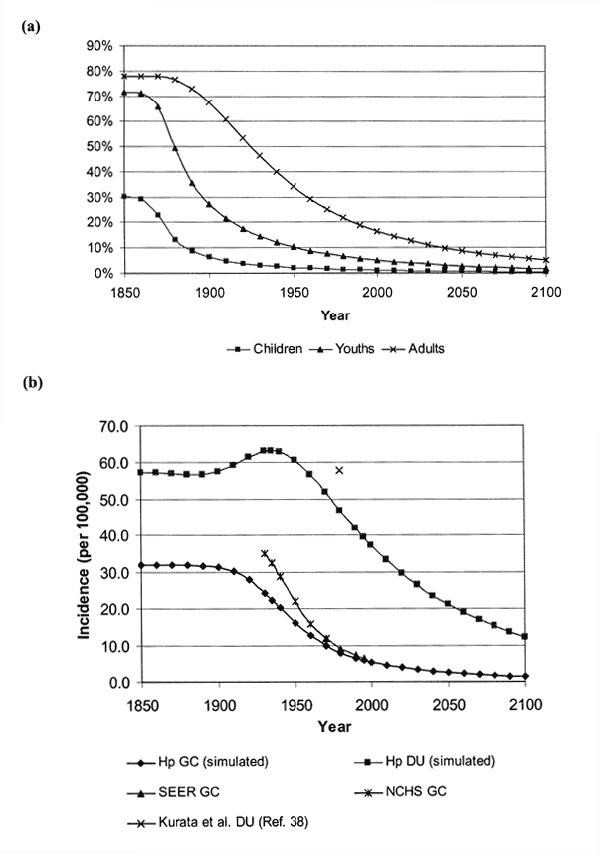Volume 6, Number 3—June 2000
Perspective
A Dynamic Transmission Model for Predicting Trends in Helicobacter pylori and Associated Diseases in the United States
Figure 3

Figure 3. Simulated temporal change in Helicobacter pylori and associated diseases. a) Prevalence of H. pylori in the U.S. population by age category (simulation output). b) Incidence of DU and GC per 100,000 U.S. population. "Hp GC" and "Hp DU" are simulation outputs. "SEER GC" represents incidence of GC from all cases, from the Surveillance, Epidemiology, and End Results report (25). "NCHS GC" represents incidence of GC from all cases, derived from the mortality statistics published by the National Center for Health Statistics and the Bureau of the Census (28). "Kurata et al. DU" represents incidence of DU from all cases, based on data from a large health maintenance organization in Southern California (34). The simulation model predicted that the prevalence of H. pylori, as well as incidence of H. pylori-associated DU and GC, would continue to decrease in the 21st century.
References
- Taylor DN, Parsonnet J. Epidemiology and natural history of Helicobacter pylori infection. In: Blaser MJ, Smith PD, Ravdin JI, Greenberg HB, Guerrant RL, editors. Infections of the gastrointestinal tract. New York: Raven Press; 1995. p. 551-63.
- NIH Consensus Conference. Helicobacter pylori in peptic ulcer disease. NIH Consensus Development Panel on Helicobacter pylori in Peptic Ulcer Disease. JAMA. 1994;272:65–9. DOIPubMedGoogle Scholar
- Telford JL, Ghiara P. Prospects for the development of a vaccine against Helicobacter pylori. Drugs. 1996;52:799–804. DOIPubMedGoogle Scholar
- Lee A. Vaccination against Helicobacter pylori. J Gastroenterol. 1996;31(Suppl 9):69–74. DOIPubMedGoogle Scholar
- Parsonnet J, Blaser MJ, Perez-Perez GI, Hargrett-Bean N, Tauxe RV. Symptoms and risk factors of Helicobacter pylori infection in a cohort of epidemiologists. Gastroenterology. 1992;102:41–6.PubMedGoogle Scholar
- Banatvala N, Mayo K, Megraud F, Jennings R, Deeks JJ, Feldman RA. The cohort effect and Helicobacter pylori. J Infect Dis. 1993;168:219–21.PubMedGoogle Scholar
- Parsonnet J. The incidence of Helicobacter pylori infection. Aliment Pharmacol Ther. 1995;9(Suppl 2):45–51.PubMedGoogle Scholar
- Anderson RM, May RM. Infectious diseases of humans: dynamics and control. New York: Oxford University Press; 1991.
- Kuipers EJ. Helicobacter pylori and the risk and management of associated diseases: gastritis, ulcer disease, atrophic gastritis and gastric cancer. Aliment Pharmacol Ther. 1997;11(Suppl 1):71–88. DOIPubMedGoogle Scholar
- Graham DY. Helicobacter pylori: its epidemiology and its role in duodenal ulcer disease. J Gastroenterol Hepatol. 1991;6:105–13. DOIPubMedGoogle Scholar
- Schultze V, Hackelsberger A, Günther T, Miehlke S, Roessner A, Malfertheiner P. Differing patterns of Helicobacter pylori gastritis in patients with duodenal, prepyloric, and gastric ulcer disease. Scand J Gastroenterol. 1998;33:137–42. DOIPubMedGoogle Scholar
- Sonnenberg A. Temporal trends and geographical variations of peptic ulcer disease. Aliment Pharmacol Ther. 1995;9(Suppl 2):3–12.PubMedGoogle Scholar
- Sipponen P, Kekki M, Haapakoski J, Ihamäki T, Siurala M. Gastric cancer risk in chronic atrophic gastritis: statistical calculations of cross-sectional data. Int J Cancer. 1985;35:173–7. DOIPubMedGoogle Scholar
- Sipponen P. Helicobacter pylori gastritis--epidemiology. J Gastroenterol. 1997;32:273–7. DOIPubMedGoogle Scholar
- Hansson LE, Nyrén O, Hsing AW, Bergström R, Josefsson S, Cho WH, The risk of stomach cancer in patients with gastric or duodenal ulcer disease. N Engl J Med. 1996;335:242–9. DOIPubMedGoogle Scholar
- Blaser MJ, Chyou PH, Nomura A. Age at establishment of Helicobacter pylori infection and gastric carcinoma, gastric ulcer, and duodenal ulcer risk. Cancer Res. 1995;55:562–5.PubMedGoogle Scholar
- Correa P, Cuello C, Duque E, Burbano LC, Garcia F, Bolanos O, Gastric cancer in Colombia. III. Natural history of precursor lesions. J Natl Cancer Inst. 1976;57:1027–35.PubMedGoogle Scholar
- U.S. National Office of Vital Statistics. Abridged life tables--United States, 1950. Vital Statistics--Special Reports 1953;37:333-43.
- Gibson C. Population of the 100 largest cities and other urban places in the United States: 1790 to 1990: U.S. Census Bureau, 1998. Available from: URL: http://www.census.gov/population/www/documentation/twps0027.html.
- Feldman RA, Eccersley AJ, Hardie JM. Epidemiology of Helicobacter pylori: acquisition, transmission, population prevalence and disease-to-infection ratio. Br Med Bull. 1998;54:39–53.PubMedGoogle Scholar
- Graham DY. Helicobacter pylori infection in the pathogenesis of duodenal ulcer and gastric cancer: a model. Gastroenterology. 1997;113:1983–91. DOIPubMedGoogle Scholar
- Valle J, Kekki M, Sipponen P, Ihamäki T, Siurala M. Long-term course and consequences of Helicobacter pylori gastritis. Results of a 32-year follow-up study. Scand J Gastroenterol. 1996;31:546–50. DOIPubMedGoogle Scholar
- Bonnevie O. The incidence of duodenal ulcer in Copenhagen county. Scand J Gastroenterol. 1975;10:385–93.PubMedGoogle Scholar
- Bonnevie O. The incidence of gastric ulcer in Copenhagen county. Scand J Gastroenterol. 1975;10:231–9.PubMedGoogle Scholar
- Cancer Statistics Review SEER. 1973-1995, 1998. Available from: URL: http://www-seer.ims.nci.nih.gov/Publications/CSR7395.
- Karnes WE, Samloff IM, Siurala M. Positive serum antibody and negative tissue staining for Helicobacter pylori in subjects with atrophic body gastritis. Gastroenterology. 1991;101:167–74.PubMedGoogle Scholar
- American Cancer Society. Cancer facts and figures-- 1998. New York: The Society; 1998.
- Garfinkel L. Cancer statistics and trends. In: Murphy GP, Lawrance W Jr, Lenhard RE Jr, editors. American Cancer Society textbook of clinical oncology. Atlanta: American Cancer Society; 1995. p. 1-9.
- Susser M. Causes of peptic ulcer. A selective epidemiologic review. J Chronic Dis. 1967;20:435–56. DOIPubMedGoogle Scholar
- Sonnenberg A. Factors which influence the incidence and course of peptic ulcer. Scand J Gastroenterol Suppl. 1988;155:119–40. DOIPubMedGoogle Scholar
- Sonnenberg A. Geographic and temporal variations in the occurrence of peptic ulcer disease. Scand J Gastroenterol Suppl. 1985;110:11–24. DOIPubMedGoogle Scholar
- Kuipers EJ, Thijs JC, Festen HP. The prevalence of Helicobacter pylori in peptic ulcer disease. Aliment Pharmacol Ther. 1995;9(Suppl 2):59–69.PubMedGoogle Scholar
- Kurata JH, Honda GD, Frankl H. The incidence of duodenal and gastric ulcers in a large health maintenance organization. Am J Public Health. 1985;75:625–9. DOIPubMedGoogle Scholar
- Hoy S. Chasing dirt. New York: Oxford University Press; 1995.
- Williams JR, Nokes DJ, Medley GF, Anderson RM. The transmission dynamics of hepatitis B in the UK: a mathematical model for evaluating costs and effectiveness of immunization programmes [published erratum appears in Epidemiol Infect 1996 Oct;117:409]. Epidemiol Infect. 1996;116:71–89. DOIPubMedGoogle Scholar
- Porco TC, Blower SM. Quantifying the intrinsic transmission dynamics of tuberculosis. Theor Popul Biol. 1998;54:117–32. DOIPubMedGoogle Scholar